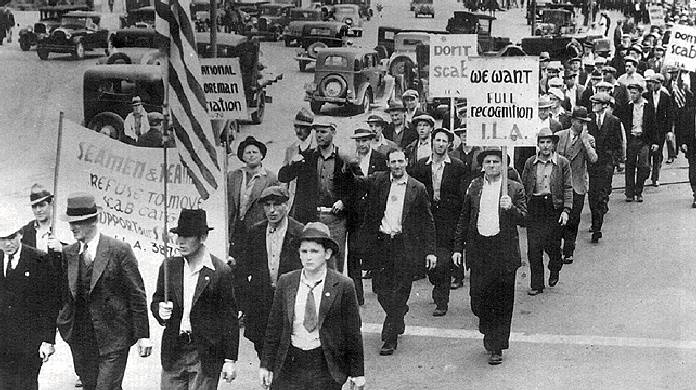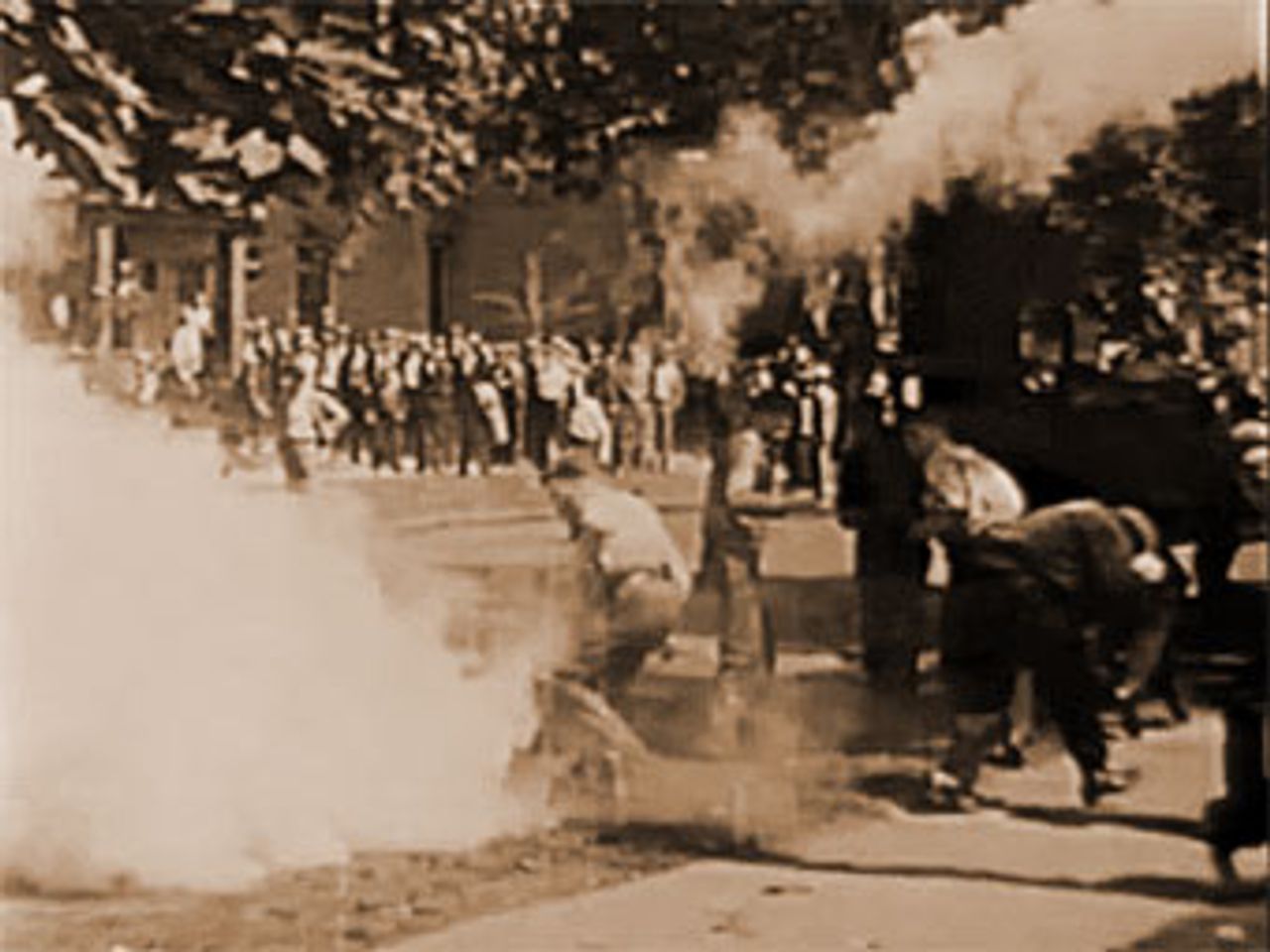In 1954, union membership as a percentage of the entire US workforce reached an all-time high of almost 35% (although the absolute highest number of union members didn't hit peak until 1979, at 21 million). The Census Bureau declared that by the middle of that decade, the middle class encompassed 60% of the US population. The American Federation of Labor (AFL) and the Congress of Industrial Organizations (CIO) merged to form the AFL-CIO, ending two decades of internecine warfare--and leaving much of the business community fretting about the growing power of those they labelled "union bosses." This apparent strength masked weaknesses in the movement, however; coupled with the postwar shift into a "post-industrial" economy, this meant that by the early 1970s, organized labor found that the rug had been pulled out from under them, and they were ill-equipped to deal with the consequences.
To illustrate this, we will look at five discrete events that happened in the 35 years between 1950 and 1985: the 1950 "Treaty of Detroit"; the 1959 Steel Strike; the 1970 General Motors strike; the 1978 Chrysler "bail-out," and the 1981 PATCO strike. These events will illustrate the limits of union power during the era, and how ill-prepared the movement was as the ground shifted beneath their feet.
1950 "Treaty of Detroit"
After attempting to get GM to "open the books" in 1945, UAW president Walter Reuther had been able to solidify his control of the UAW, and obtain ever more generous contracts for his members. Doing so usually necessitated lengthy, annual strikes, which slowed production--much to the frustration of management, who wanted longer contracts that would allow them to project costs into the future. In 1950, Reuther acquiesced on this point. In return for a substantial raise, health care, and a pension plan, GM received agreement for a five-year contract. This contract, in fact, proved to be too long for union tastes, which found itself having to plead for a wage re-opener before the contract was up, because inflation ate away most to of the raise; after 1955, new contracts were negotiated every three years. But the pattern had been set--in return for generous contracts, management sought stable relations with it workers, and largely got union officials themselves to enforce factory discipline.
To accomplish this, Reuther believed that productivity in factories had to continually improve--which meant that more work had to be done by fewer people. This meant that the union took no action as more machinery moved into factories, and fewer workers were hired to work in these same factories. There is an apocryphal story told about a Ford Motor Company official giving a tour to Reuther of the new Cleveland Engine plant in Brook Park, at the time the most highly-automated foundry in the world. The company official was supposed to have smirked to Reuther, "None of these machines will every pay a dime of union dues." Reuther is alleged to have retorted, "And none will be buying Ford cars, either." Ironically, both men were later proved correct.
1959 Steel Strike
The difficulty and danger of resisting managements' push for greater productivity in perhaps illustrated by the 1959 Steel Strike. The Steelworkers had a clause in their contract that prevented companies from changing the number of workers assigned to any particular job. In contract negotiations that year, this became a real sticking pointAfter a protracted fight, the Steelworkers were able to protect that clause--despite President Eisenhower's invocation of a clause in Taft-Hartley that forced the workers back on the job because of a "national emergency," and losing an attempt to get the Supreme Court to decide the clause unconstitutional. Because of the length of the strike, however, many steel consumers had begun importing steel, which they found cheaper than US-made steel despite shipping costs (because of lower labor costs and government supports that allowed foreign companies to sell steel below their cost) In 1962 contract negotiation, while retaining the clause, Steelworkers' president David McDonald offer not to enforce the clause; by 1965 this stand cost McDonald his position, and dissatisfied rank-and-file member swept an insurgent slate. Despite this mandate from the membership, however, the clause was negotiated away in the next round of contract talks. Despite these concessions, however, US steel manufacturers were unable to regain the ground lost, and the industry continued to spiral downward throughout the 1960s and 1970s, resulting in Black Monday, September 19, 1977 in Youngstown, Ohio.
1970 General Motors Strike
In part because of the level of military spending as a result of the US involvement in the war in Vietnam, a super-heated economy was sending the prices of most consumer goods through the roof (a condition made even worse in the fall of 1973, when an oil embargo doubled the price of gasoline overnight in the country). The response to these greater costs on the part of industry was to seek ever increasing productivity levels from workers, while trying to hold the line on wage increases. Into this situation stepped a new president of the UAW, Leonard Woodcock, who had taken over for Walter Reuther when the latter was killed (with his wife) in a small plane crash. Woodcock was not seen by most as the selected heir to the throne, so with a contract to negotiate, he was under a great deal of pressure to produce something substantive in a difficult situation. As if to increase the pressure on gaining important concessions, Woodcock decided to take on the most powerful of the Detroit Three, General Motors. The result was the longest strike in UAW history, and 113-day walkout that eventually got some important concessions (including a worker favorite--the ability of workers to retire with full benefits after 30 years of service, popularly known as "30-and-out"). But the union was unable to wrest any concessions on so-called "management prerogatives" like staffing levels. How important this was to workers became evident in the period after the contract was signed, when workers walked of the job in a variety of locations in protest of working conditions; perhaps the most famous of these so-called "wildcat strikes" took place in Lordstown, Ohio, where workers engaged in an extended battle with management over a variety of workplace issues.
1978 Chrysler "bail-out"
The fall-out from the oil embargo was particularly difficult for the smallest and weakest of the Detroit 3, the Chrysler Corporation. Plagued by poor management for an extended period, which had soured its relationship with its workers on the shopfloor, by the late 1970s Chrysler was having difficulty convincing its creditors that it would be a viable company into the future. Just the year before, the company had hired a former Ford Motor Company executive named Lee Iococca to head up the company's turnaround effort, which included a new small car known as the "K" car, and something called a "mini-van." Without a line of credit, however, the company would not be able to get these automobiles into production--and creditors were reluctant to lend anymore money to the company without some guarantee of getting their money back. So Chrysler turned to the federal government as its guarantee for these loans (it should be noted that the government would only be responsible for the loans if Chrysler could not make its payments). A Democratic president, along with a Democratically-controlled House of Representatives and Senate, agrees to guarantee the loans for Chrysler--if its workers agreed to wage and benefit concession. Douglas Fraser (himself a former Chrysler worker), reluctantly agreed to this--if he was given a seat on the Chrysler Board of Directors. In order to get the guarantees, Chrysler agreed to this stipulation. Initially hailed as a new, innovative approach to employer/employee relations, within three years Fraser resigned from the board, and denounced the agreement. In part, this was because during the next round of negotiations, both General Motors and Ford asked for similar concessions from the UAW in order to remain "competitive" with their smaller, weaker rival. Thus the downward spiral of concessionary bargaining began, as companies threatened to move production without ever more concession from their workers.
1981 PATCO Strike
Dissatisfied with Federal Aeronautic Administration (FAA) policies toward air traffic controllers, the Professional Air Traffic Controllers Organization (PATCO) endorsed Ronald Reagan in the 1980 election, particularly after Reagan endorsed the union's side in their dispute with the FAA. If the union officials were expecting better labor relations with officials from a Reagan administration, those expectations were crushed in August 1981. When PATCO officials authorized an illegal strike (federal employees, even those who belong to unions, are forbidden by law to strike). Reagan invoked Taft-Hartley, and gave workers 48 hours to return--or he threatened to fire them all. PATCO members, convinced the air traffic system would fall apart without them, called Reagan's bluff. Only it wasn't a bluff. Reagan fired more than 11,000 air traffic controllers, and forbid them from re-applying for their positions (this was eventually rescinded by Bill Clinton). By cutting flights in half and using supervisors and military personnel to scab (replace those fired)--and by avoiding any major accidents (although there were a number of unpublicized close calls), Reagan was able to ride out the storm over these actions--and embolden private industry to follow his wake.
Conclusion
I argue that, in part, the difficulties that labor faces today are a result of those factors that gave the movement its greatest strengths in the 20th century. When the labor movement was revitalized in the 1930s, it was in part because government actively assisted the labor movement by creating apparatus to facilitate labor organizing. These efforts were assisted by the economic conditions of the time, which severely tested people's faith in the capitalist system, and made those who challenged that system more likely to be listened to.




























